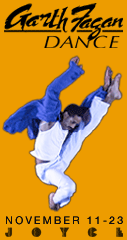
 |

|
 |

|
 |
 |
 |
 |
Go back to Flash Reviews Paris Opera Ballet Misses Balanchine; Larbi & Vandekeybus Extend Him By Paul Ben-Itzak PARIS -- A recent issue of an American magazine for ballet students treats the legacy of George Balanchine, whose centennial is being celebrated this season, by focusing on three young choreographers at the New York City Ballet, which Balanchine co-founded with Lincoln Kirstein. But Balanchine's legacy is so much broader, and not just as witnessed by the performance of his work by companies around the world. Whether you like or don't like his ballets -- this critic's opinion depends on the ballet -- you can't deny his primary contribution, which was to take an old language and give it new expression. All creators face this challenge, and speaking as an author in one medium about authors in another, I don't know how they do it. The combination possibilities -- on one body and in tandem with others -- would seem to me limited. And yet Balanchine, like Michel Fokine before him and Forsythe after him -- working with, to borrow my colleague Gus Solomons jr's phrase from his Forsythe review of today, pathologically committed dancers -- managed to expand the creative potential of the body and its rhythms. That exploration isn't confined to choreographers working in the ballet idiom, as a recent concert by Sidi Larbi Cherkaoui in collaboration with Wim Vandekeybus reminded me -- but let's start with Balanchine. The first time I saw the Paris Opera Ballet essay Balanchine, in a representation of his early work created for Diaghilev's Ballets Russes, "Apollo, Leader of the Muses," I titled my review "From Paris, Avec Feeling." Having been previously fed Balanchine for the most part on a strict New York City Ballet diet, I was dazzled by the joyous demeanor of Agnes Letestu and the other POB interpreters. Well, my French and my perception have since improved. In fact, as I realized after seeing the POB's season-opening all-Balanchine program Monday at the Palais Garnier, the acting ability which is normally this company's strength becomes in Balanchine, at least on the part of the premiere and etoile dancers, their weakness. (Local color injection: As I write this, six floors below my balcony on the rue de Paradis a street organ-grinder is playing "La Vie en Rose," on this 40th anniversary of the death of Edith Piaf.) I won't spend a lot of time on "Symphony in C," but I've got to start by asking why the Paris Opera has confusingly publicized this showing alternately under that name and as "The Crystal Palace" -- the title under which the ballet premiered at the Paris Opera in 1947, before assuming its current title at its 1948 premiere on Ballet Society. Most notably, it would have been a great opportunity to attempt to resurrect the scenery and costumes of the surrealist painter Leonor Fini. That would have at least given this production some claim to legitimacy, which, with the exception of the irreproachable Aurelie Dupont in the third section, the dancing did not. In a word -- or a phrase -- I didn't see the music, a severe misrepresentation when seeking to represent Balanchine. (And it wasn't the fault of the Opera's orchestra, vividly conducted as always by Paul Connelly.) Clairemarie Osta -- a favorite -- got things off to a bad start by deploying her cloying, direct approach to the audience, endearing usually, but a gross misapprehension for abstract Balanchine. There's nothing wrong with letting the music animate you, but personality should not be involved. Dupont, by contrast, simply gave herself over to the Georges Bizet music, completely trusting it and her reliable if wooden partner, Yann Saiz. Where Osta's eyes all but winked at us, Dupont's were somewhere else, in the land of musical enchantment, and she took us there too, right down to the finish, when she sloped and a languid arm floated up. The ethereal (when called for -- she can also be real when the role so requires) Dupont notwithstanding, the pattern of the evening was set by Osta, and it was to be one of principals disappointing me by doing that with which they usually charm me. Readers of this publication probably don't need to be told that Balanchine did not mean for the four temperaments in his 1946 ballet of the same name to be enacted literally, but perhaps someone should tell Patricia Neary, the Balanchine Trust supervisor of this program, to re-read what Balanchine wrote on the ballet in his 1954 "Stories of the Great Ballets," edited by Francis Mason and published by Doubleday: "Subtitled 'A Dance Ballet without Plot," 'The Four Temperaments' is an expression in dance and music of the ancient notion that the human organism is made up of four different humors, or temperaments... melancholic, sanguinic, phlegmatic, and choleric.... Although the (Paul Hindemith) score is based on this idea of the four temperaments, neither the music nor the ballet itself make specific or literal interpretation of the idea. An understanding of the Greek and medieval notion of the temperaments was merely the point of departure for both composer and choreographer." For Muriel Halle and Christophe Duquenne, the first of three couples in the introductory "Theme" section, the point of departure was indeed the music, outlined with clean limbs and crystalline duet combinations. The rest of the demi-soloists -- including Melanie Hurel, Nathalie Rique, Gil Isoart and Herve Moreau -- confined themselves to elaborating the musical theme. But Laurent Hilaire -- again, a personal favorite -- tried a shortcut, simply using the music to go into his Melancholy act. I've appreciated Hilaire's pathos in the past, but here it really short-changed the music. Laetitia Pujol was "I'm happy really happy!" in the Sanguinic section, albeit trotted about by the dour Wilfried Romoli. Jose Martinez went into his plastic man schtick for most of Phlegmatic, but did recover at the end for a sad lilting of the head which, while not exactly phlegmatic, at least was true... to the music. Karine Averty was acerbic, but that's my reaction and it could have been an honest if brittle response to the music. As I've previously written, Nicolas Le Riche's "Prodigal Son" fails to catch the beautiful, almost biblical friezes en l'air of NYCB's Damian Woetzel and Peter Boal, or Dance Theatre of Harlem's Duncan Cooper. This was still the case Monday, but Le Riche's interpretation has slackened in other ways too. His fascination with Marie-Agnes Gillot's Siren is essentially sexless. Her demeanor towards him, too, is anti-septic, a mistake in interpretation, I think; based on what I've seen before -- for example, danced by DTH's Caroline Rocher as instructed by Suzanne Farrell -- the Siren may be calculating, but she's not cold. For her to attain her mercenary ends, she has to emit some sexual appeal, and there's little of that here. 'Prodigal' insiders will want to know how Gillot did with the cape: She handled it for the most part unconsciously, until she got under it, where it was apparent from the fumbling that she was trying to unfasten the garment. And speaking of garments, what was Le Riche doing sporting an earring? Perhaps Balanchine experts know different, but somehow I can't imagine George Roualt having included this jewelry in his original design, nor it flapping from Edward Villella's ear as it did from Le Riche's until Gillot yanked it off. As for the choreography, well, I only realized about ten minutes into the 50-minute piece that I'd just seen a fluid elaboration on B-boy spinning, upside down and then balanced on one hand. Hip-hop has certainly been used to craft concert dance before -- most successfully by Rennie Harris -- but with Larbi, you don't realize he's doing it. He's not trying to create a hip-hop ballet; rather, hip-hop is just one tool in this (and Vandekeybus's) dancer-choreographer's bag, with the result that its use is less self-conscious. The article I referenced above refers to a "third generation" in the Balanchine mode, apparently qualified by the fact that they create for or came from Balanchine's company. But I think Larbi better meets the tradition of Fokine, Balanchine, and Forsythe; like them, he's generating new ways to use the dancing body. "It," a production of Ultima Vez with Les Ballets C. de la B. and the Theatre de la Ville, continues through tomorrow night at the Theater aux Abbesses of the Theatre de la Ville. |
|||||||


